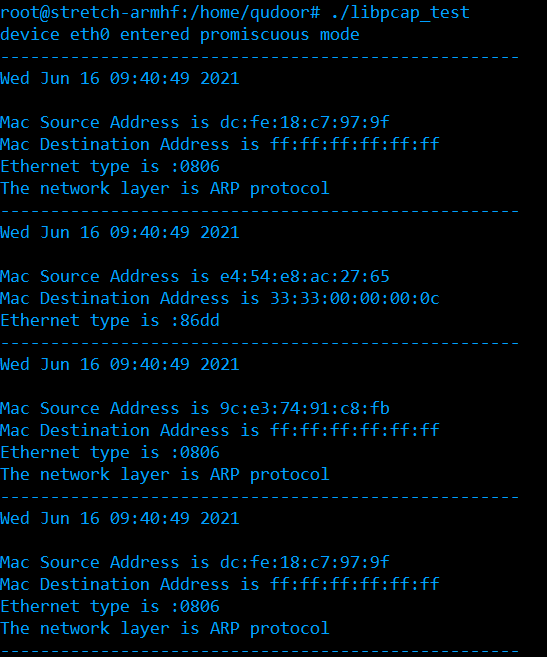参考文章:
一、libpcap库下载
二、libpcap库交叉编译安装
-
配置交叉编译环境
-
下载最新版本 libpcap-1.10.1.tar.gz,解压缩到当前目录:
tar -xzvf ./libpcap-1.10.1.tar.gz -C ./ -
配置安装目录和交叉编译环境
./configure --prefix=/xxx/xxx/install/ --host=arm-linux-gnueabihf -
编译
make -
安装
make install在 install/lib/ 目录下生成如下文件:

-
cd 进入 install 安装目录,打包lib目录下动态库文件
tar -zcvf libpcap-1.10.1-install.tar.gz lib/*.so* -
将 libpcap-1.10.1-install.tar.gz 压缩包拷贝到开发板上,解压
新建文件夹:/usr/local/lib/libpcap , 然后解压到该文件夹中sudo mkdir /usr/local/lib/libpcapsudo tar -zxf ./libpcap-1.10.1-install.tar.gz --strip-components 1 -C /usr/local/lib/libpcap -
开发板上添加库文件搜索路径
打开ld.so.conf文件sudo vi /etc/ld.so.conf.d/libc.conf在 /etc/ld.so.conf 文件中添加库的搜索路径
/usr/local/lib/libpcap //根据自己的库路径添加然后
ldconfig生成/etc/ld.so.cache,ldconfig -v查看sudo ldconfig
三、应用程序交叉编译
交叉编译应用程序:需要加 -lpcap 选项,并指定头文件及动态库路径
arm-linux-gnueabihf-gcc ./libpcap_test.c -o ./libpcap_test -lpcap -I/xxx/include/ -L/xxx/lib/
-
查看头文件及动态库路径
Libpcap 安装为一个库和一组包含文件。在您的程序中使用的主要包含文件是:#include <pcap.h>要获得头文件和库文件的正确搜索路径,请使用标准pkg-config工具:
pkg-config --libs --static --cflags libpcap结果:
-I/usr/local/include -L/usr/local/lib -lpcap/usr/local/此处显示的路径为默认值。configure时,可以使用 --prefix 选项指定不同的路径。
-
编译需要添加 -lpcap 选项
gcc test.c -o test -lpcap -
基于 GNU autotools 的项目,请在以下内容中使用
configure.ac:# Check for required libraries PKG_CHECK_MODULES([libpcap], [libpcap>= 1.2])并在您的
Makefile.am:proggy_CFLAGS = $(libpcap_CFLAGS) proggy_LDADD = $(libpcap_LIBS)
四、Ubuntu系统安装 libpcap(非交叉编译)
-
libpcap 的安装
sudo apt-get install libpcap-dev -
应用程序编译
gcc libpcap_test.c -o libpcap_test -lpcap
五、libpcap使用
参考:
六、开发板上测试
使用 libpcap 循环捕获网络数据包(libpcap_test.c):
#include <stdio.h>
#include <pcap.h>
#include <arpa/inet.h>
#include <time.h>
#include <stdlib.h>
#define BUFSIZE 1514
struct ether_header
{
unsigned char ether_dhost[6]; //目的mac
unsigned char ether_shost[6]; //源mac
unsigned short ether_type; //以太网类型
};
/*******************************回调函数************************************/
void ethernet_protocol_callback(unsigned char *argument,const struct pcap_pkthdr *packet_heaher,const unsigned char *packet_content)
{
unsigned char *mac_string; //
struct ether_header *ethernet_protocol;
unsigned short ethernet_type; //以太网类型
printf("----------------------------------------------------\n");
printf("%s\n", ctime((time_t *)&(packet_heaher->ts.tv_sec))); //转换时间
ethernet_protocol = (struct ether_header *)packet_content;
mac_string = (unsigned char *)ethernet_protocol->ether_shost;//获取源mac地址
printf("Mac Source Address is %02x:%02x:%02x:%02x:%02x:%02x\n",*(mac_string+0),*(mac_string+1),*(mac_string+2),*(mac_string+3),*(mac_string+4),*(mac_string+5));
mac_string = (unsigned char *)ethernet_protocol->ether_dhost;//获取目的mac
printf("Mac Destination Address is %02x:%02x:%02x:%02x:%02x:%02x\n",*(mac_string+0),*(mac_string+1),*(mac_string+2),*(mac_string+3),*(mac_string+4),*(mac_string+5));
ethernet_type = ntohs(ethernet_protocol->ether_type);//获得以太网的类型
printf("Ethernet type is :%04x\n",ethernet_type);
switch(ethernet_type)
{
case 0x0800:printf("The network layer is IP protocol\n");break;//ip
case 0x0806:printf("The network layer is ARP protocol\n");break;//arp
case 0x0835:printf("The network layer is RARP protocol\n");break;//rarp
default:break;
}
usleep(800*1000);
}
int main(int argc, char *argv[])
{
char error_content[100]; //出错信息
pcap_t * pcap_handle;
unsigned char *mac_string;
unsigned short ethernet_type; //以太网类型
char *net_interface = NULL; //接口名字
struct pcap_pkthdr protocol_header;
struct ether_header *ethernet_protocol;
//获取网络接口
net_interface = pcap_lookupdev(error_content);
if(NULL == net_interface)
{
perror("pcap_lookupdev");
exit(-1);
}
pcap_handle = pcap_open_live(net_interface,BUFSIZE,1,0,error_content);//打开网络接口
if(pcap_loop(pcap_handle,-1,ethernet_protocol_callback,NULL) < 0)
{
perror("pcap_loop");
}
pcap_close(pcap_handle);
return 0;
}
交叉编译:
arm-linux-gnueabihf-gcc ./libpcap_test.c -o ./libpcap_test -lpcap -I/home/osrc/Projects/tools/libpcap/install/include/ -L/home/osrc/Projects/tools/libpcap/install/lib
在开发板上运行,需要root账户权限:
sudo ./libpcap_test
结果如下:

使用 libpcap 过滤目的端口为8080的数据包,循环捕获(libpcap_filter_test.c);
#include <pcap.h>
#include <time.h>
#include <stdlib.h>
#include <stdio.h>
/*
* src host 192.168.1.177 //只接收源 ip 地址是 192.168.1.177 的数据包
* dst port 80 //只接收 tcp/udp 的目的端口是 80 的数据包
* not tcp //只接收不使用 tcp 协议的数据包
* tcp[13] == 0x02 and (dst port 22 or dst port 23) //只接收 SYN 标志位置位且目标端口是 22 或 23 的数据包( tcp 首部开始的第 13 个字节)
* icmp[icmptype] == icmp-echoreply or icmp[icmptype] == icmp-echo //只接收 icmp 的 ping 请求和 ping 响应的数据包
* ehter dst 00:e0:09:c1:0e:82 //只接收以太网 mac 地址是 00:e0:09:c1:0e:82 的数据包
*/
#define PACP_FILTER "dst port 8080"
struct ether_header
{
unsigned char ether_dhost[6]; //目的mac
unsigned char ether_shost[6]; //源mac
unsigned short ether_type; //以太网类型
};
void getPacket(u_char * arg, const struct pcap_pkthdr * pkthdr, const u_char * packet)
{
int * id = (int *)arg;
unsigned char *mac_string; //
struct ether_header *ethernet_protocol;
unsigned short ethernet_type; //以太网类型
printf("----------------------------------------------------\n");
printf("id: %d\n", ++(*id));
printf("Packet length: %d\n", pkthdr->len);
printf("Number of bytes: %d\n", pkthdr->caplen);
printf("Recieved time: %s", ctime((const time_t *)&pkthdr->ts.tv_sec));
ethernet_protocol = (struct ether_header *)packet;
mac_string = (unsigned char *)ethernet_protocol->ether_dhost;//获取目的mac
printf("Mac Destination Address is %02x:%02x:%02x:%02x:%02x:%02x\n",*(mac_string+0),*(mac_string+1),*(mac_string+2),*(mac_string+3),*(mac_string+4),*(mac_string+5));
mac_string = (unsigned char *)ethernet_protocol->ether_shost;//获取源mac地址
printf("Mac Source Address is %02x:%02x:%02x:%02x:%02x:%02x\n",*(mac_string+0),*(mac_string+1),*(mac_string+2),*(mac_string+3),*(mac_string+4),*(mac_string+5));
ethernet_type = ntohs(ethernet_protocol->ether_type);//获得以太网的类型
printf("Ethernet type is :%04x\n",ethernet_type);
switch(ethernet_type)
{
case 0x0800:printf("The network layer is IP protocol\n");break;//ip
case 0x0806:printf("The network layer is ARP protocol\n");break;//arp
case 0x0835:printf("The network layer is RARP protocol\n");break;//rarp
default:break;
}
int i;
for(i=0; i<pkthdr->len; ++i)
{
printf(" %02x", packet[i]);
if( (i + 1) % 16 == 0 )
{
printf("\n");
}
}
printf("\n\n");
}
void getOnePacket(pcap_t * device)
{
struct pcap_pkthdr protocol_header;
struct ether_header *ethernet_protocol;
const unsigned char *p_packet_content = NULL; // 保存接收到的数据包的起始地址
unsigned char *p_mac_string = NULL; // 保存mac的地址,临时变量
unsigned short ethernet_type = 0; // 以太网类型
p_packet_content = pcap_next(device,&protocol_header);
printf("------------------------------------------------------------------------\n");
printf("Capture Time is :%s",ctime((const time_t *)&protocol_header.ts.tv_sec));
printf("Packet Lenght is :%d\n",protocol_header.len);
/*
*分析以太网中的 源mac、目的mac
*/
ethernet_protocol = (struct ether_header *)p_packet_content;
p_mac_string = (unsigned char *)ethernet_protocol->ether_shost;//获取源mac
printf("Mac Source Address is %02x:%02x:%02x:%02x:%02x:%02x\n",*(p_mac_string+0),*(p_mac_string+1),*(p_mac_string+2),*(p_mac_string+3),*(p_mac_string+4),*(p_mac_string+5));
p_mac_string = (unsigned char *)ethernet_protocol->ether_dhost;//获取目的mac
printf("Mac Destination Address is %02x:%02x:%02x:%02x:%02x:%02x\n",*(p_mac_string+0),*(p_mac_string+1),*(p_mac_string+2),*(p_mac_string+3),*(p_mac_string+4),*(p_mac_string+5));
/*
*获得以太网的数据包的地址,然后分析出上层网络协议的类型
*/
ethernet_type = ntohs(ethernet_protocol->ether_type);
printf("Ethernet type is :%04x\t",ethernet_type);
switch(ethernet_type)
{
case 0x0800:printf("The network layer is IP protocol\n");break;//ip
case 0x0806:printf("The network layer is ARP protocol\n");break;//arp
case 0x0835:printf("The network layer is RARP protocol\n");break;//rarp
default:printf("The network layer unknow!\n");break;
}
}
int main()
{
char errBuf[PCAP_ERRBUF_SIZE], * devStr;
/* get a device */
devStr = pcap_lookupdev(errBuf);
if(devStr)
{
printf("success: device: %s\n", devStr);
}
else
{
printf("error: %s\n", errBuf);
exit(1);
}
/* open a device, wait until a packet arrives */
pcap_t * device = pcap_open_live(devStr, 65535, 1, 1, errBuf); //设置超时时间为1ms,超时后获取数据包的函数就会立即返回
if(!device)
{
printf("error: pcap_open_live(): %s\n", errBuf);
exit(1);
}
/* construct a filter */
struct bpf_program filter;
pcap_compile(device, &filter, PACP_FILTER, 1, 0);
pcap_setfilter(device, &filter);
/* wait loop forever */
int id = 0;
pcap_loop(device, -1, getPacket, (u_char*)&id);
// while(1)
// {
// getOnePacket(device);
// }
pcap_close(device);
return 0;
}
说明:
pcap_open_live函数的 to_ms 参数指定超时时间(毫秒)可控制 pcap_loop 函数中的 callback 函数回调时间。





















 1万+
1万+











 被折叠的 条评论
为什么被折叠?
被折叠的 条评论
为什么被折叠?








